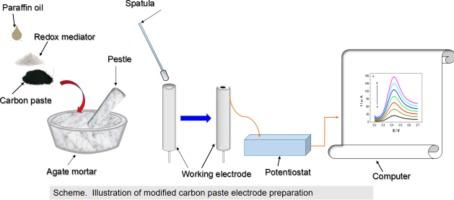A manganese phthalocyanine histidine composite-modified carbon paste electrode as a biomimetic sensor for bisphenol A determination
IF 2.5
Q2 CHEMISTRY, MULTIDISCIPLINARY
引用次数: 0
Abstract
A biomimetic sensor was prepared from carbon paste electrode (CPE) modified with manganese phthalocyanine (MnPc) and histidine (His), and used for the determination of bisphenol A (BPA). The electrochemical biomimetic sensor (MnPc-His-CPE) gave significant current responses for BPA oxidation in comparison with CPE and MnPc-CPE, individually. The morphological and chemical characterizations of the sensor surface were studied by FT-IR, UV-visible Spectrophotometry, and SEM. The electrochemical behavior of the sensor and the oxidation behavior of BPA at the MnPc-His-CPE/BPA interface were investigated by cyclic voltammetry (CV), chronocoulometry (CC), square wave voltammetry (SWV), and electrochemical impedance spectroscopy (EIS). Square wave voltammetry (SWV), applied as a sensitive analytical method for BPA determination, led to a good linear correlation between BPA concentration and peak current in the range from 2.10−8 mol.L−1 to 5.10−5 mol.L−1 and a detection limit of 4.63 nM (S/N = 3). The relative standard deviation was 4.10 % (n = 10). The proposed sensor was found to be highly selective for BPA. In addition, the reproducibility and stability of the sensor were found to be satisfactory. The accuracy of the electrochemical biomimetic sensor was compared with HPLC method. The sensor has been successfully applied for the determination of BPA from real water samples with a good recovery, ranging from 91.40 % to 106.30 %.

酞菁锰-组氨酸复合材料修饰碳糊电极测定双酚A的仿生传感器
以酞菁锰(MnPc)和组氨酸(His)修饰碳糊电极(CPE)制备仿生传感器,用于双酚A (BPA)的测定。与CPE和MnPc-CPE相比,电化学仿生传感器(MnPc-His-CPE)对BPA氧化的电流响应显著。利用傅里叶变换红外光谱、紫外可见分光光度和扫描电镜对传感器表面进行了形貌和化学表征。采用循环伏安法(CV)、时间伏安法(CC)、方波伏安法(SWV)和电化学阻抗谱法(EIS)研究了传感器的电化学行为和BPA在MnPc-His-CPE/BPA界面上的氧化行为。采用方波伏安法(SWV)检测双酚a的灵敏度较高,双酚a浓度与峰值电流在2.10 ~ 8 ~ 5.10 ~ 5 mol.L - 1范围内呈良好的线性关系,检出限为4.63 nM (S/N = 3),相对标准偏差为4.10% (N = 10)。发现该传感器对BPA具有高度选择性。此外,该传感器的重现性和稳定性令人满意。比较了电化学仿生传感器与高效液相色谱法的准确度。该传感器已成功应用于实际水样中BPA的测定,回收率为91.40% ~ 106.30%。
本文章由计算机程序翻译,如有差异,请以英文原文为准。
求助全文
约1分钟内获得全文
求助全文

 求助内容:
求助内容: 应助结果提醒方式:
应助结果提醒方式:


